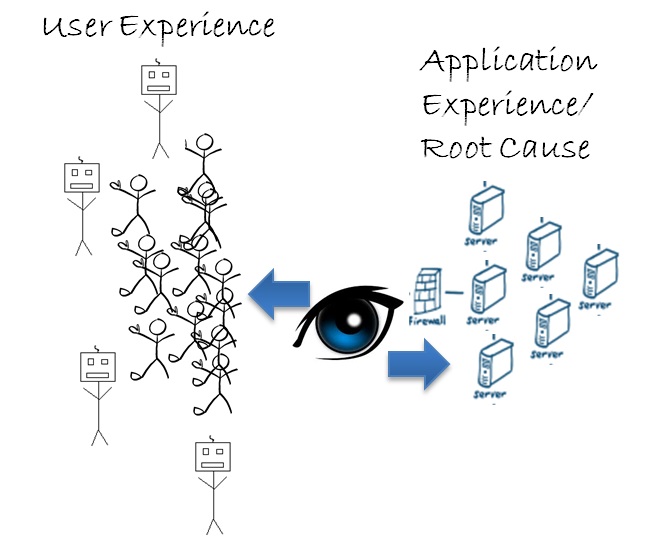The ability to view things from the end user perspective and to drill down into the code level deep dive can be extremely powerful, and the information gathered from this ability provides DevOps teams with an instant view into the direct root cause of any user experience problem they may not otherwise have noticed.
Traditional real-user monitoring (RUM) techniques provide insight into how your user actually interacts with your website or application. Synthetic monitoring, particularly when using real browsers, provides a similar assessment of expected user experience along with the benefits of true availability monitoring, third-party impact, and consistent baselining capabilities.
Combining synthetic and RUM gives a complete view of the user experience along with high level root cause clues. RUM, by itself, can miss outages, page errors, and third-party problems. Synthetic, by itself, is really only a proxy for real-user experience and can miss problems experienced by various user populations. Using both techniques in tandem eliminates those inherent blind spots and can provide an organization with the best view of their users’ experience – both actual and potential.

But monitoring user experience only tells you half of the story. The ability to look at things from the application/back-end perspective and drill down to the code (or up to end-user transactions) is a powerful root cause identifier. By discovering problems in delivery, DevOps teams can work to prevent or minimize user impact on their software.
Application and server monitoring provide insight into relative transaction performance. Furthermore, it provides an accurate view into the root cause of user experience degradation in your own infrastructure. These tools allow developers to identify issues before code is deployed while simultaneously giving ops teams the tools to address issues and communicate to app owners in real time. Providing this flexible view of user experience and application health provides a clear view of impact and root cause, allowing dev and ops to work together prevent and minimize damaging negative user experiences. Having all of this working together at the same time will do wonders for your overall relationship with your end user.
The ability to pivot the perspective from user experience to application transaction performance can give your organization a powerful view into user experience and root cause diagnostics. Put another way, it helps to answer the “what” along with (possibly more importantly) the “why” when it comes to performance issues. When these perspectives are seamlessly tied together and are easily available to a variety of technical and business users, the result can only be APM awesomeness!
Denis Goodwin is Director of Product Management for APM at SmartBear.
The Latest
The use of hybrid multicloud models is forecasted to double over the next one to three years as IT decision makers are facing new pressures to modernize IT infrastructures because of drivers like AI, security, and sustainability, according to the Enterprise Cloud Index (ECI) report from Nutanix ...
Over the last 20 years Digital Employee Experience has become a necessity for companies committed to digital transformation and improving IT experiences. In fact, by 2025, more than 50% of IT organizations will use digital employee experience to prioritize and measure digital initiative success ...
While most companies are now deploying cloud-based technologies, the 2024 Secure Cloud Networking Field Report from Aviatrix found that there is a silent struggle to maximize value from those investments. Many of the challenges organizations have faced over the past several years have evolved, but continue today ...
In our latest research, Cisco's The App Attention Index 2023: Beware the Application Generation, 62% of consumers report their expectations for digital experiences are far higher than they were two years ago, and 64% state they are less forgiving of poor digital services than they were just 12 months ago ...
In MEAN TIME TO INSIGHT Episode 5, Shamus McGillicuddy, VP of Research, Network Infrastructure and Operations, at EMA discusses the network source of truth ...
A vast majority (89%) of organizations have rapidly expanded their technology in the past few years and three quarters (76%) say it's brought with it increased "chaos" that they have to manage, according to Situation Report 2024: Managing Technology Chaos from Software AG ...
In 2024 the number one challenge facing IT teams is a lack of skilled workers, and many are turning to automation as an answer, according to IT Trends: 2024 Industry Report ...
Organizations are continuing to embrace multicloud environments and cloud-native architectures to enable rapid transformation and deliver secure innovation. However, despite the speed, scale, and agility enabled by these modern cloud ecosystems, organizations are struggling to manage the explosion of data they create, according to The state of observability 2024: Overcoming complexity through AI-driven analytics and automation strategies, a report from Dynatrace ...
Organizations recognize the value of observability, but only 10% of them are actually practicing full observability of their applications and infrastructure. This is among the key findings from the recently completed Logz.io 2024 Observability Pulse Survey and Report ...
Businesses must adopt a comprehensive Internet Performance Monitoring (IPM) strategy, says Enterprise Management Associates (EMA), a leading IT analyst research firm. This strategy is crucial to bridge the significant observability gap within today's complex IT infrastructures. The recommendation is particularly timely, given that 99% of enterprises are expanding their use of the Internet as a primary connectivity conduit while facing challenges due to the inefficiency of multiple, disjointed monitoring tools, according to Modern Enterprises Must Boost Observability with Internet Performance Monitoring, a new report from EMA and Catchpoint ...






